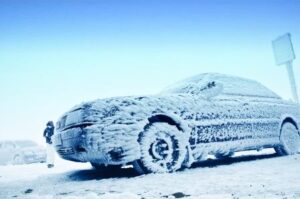“Protect your vehicle from the damaging effects of low or minus temperatures on fuel lines. Visit BuyFromNorm.ca to find high-quality fuel line products that will keep your vehicle running smoothly all winter long.”
How to Winterize Your Vehicle’s Fuel Lines for Minus Temperatures
Winter is a beautiful season, with snow-covered landscapes and cozy nights by the fire. However, it also brings along some challenges, especially when it comes to our vehicles. One of the most common issues during the winter months is the freezing of fuel lines. This can cause major problems for your vehicle, leaving you stranded in the cold. In this article, we will discuss what low or minus temperatures can do with vehicle fuel lines and how you can winterize them to avoid any potential issues.
First and foremost, it is important to understand how fuel lines work. Fuel lines are responsible for carrying fuel from the gas tank to the engine. They are usually made of metal or plastic and are designed to withstand high pressure and extreme temperatures. However, when the temperature drops below freezing, the fuel inside the lines can turn into a gel-like substance, clogging the lines and preventing the flow of fuel to the engine.
So, what exactly happens when the fuel lines freeze? Well, for starters, your vehicle will have a hard time starting. This is because the engine needs a constant supply of fuel to run, and if the fuel lines are frozen, the engine won’t get the fuel it needs. In some cases, the engine may start, but it will run rough and eventually stall. This can be a major inconvenience, especially if you are in a remote area or on a busy highway.
Moreover, frozen fuel lines can also cause damage to your vehicle. When the fuel lines are clogged, the fuel pump has to work harder to push the fuel through, which can lead to overheating and potential damage to the pump. In extreme cases, the pressure from the frozen fuel can cause the lines to burst, resulting in costly repairs.
Now that we understand the potential consequences of frozen fuel lines, let’s discuss how we can prevent them. The key to winterizing your vehicle’s fuel lines is to keep the fuel from freezing. One way to do this is by using a fuel line antifreeze. This is a special additive that you can pour into your gas tank to prevent the fuel from turning into a gel-like substance. It works by lowering the freezing point of the fuel, making it less likely to freeze in low temperatures.
Another important step in winterizing your fuel lines is to keep your gas tank at least half full. This may seem like a simple tip, but it can make a big difference. When the gas tank is full, there is less room for air to circulate, which can help prevent the fuel from freezing. Additionally, having a full tank of gas will also provide you with a reserve in case you get stranded and need to keep your vehicle running for warmth.
In addition to using fuel line antifreeze and keeping your gas tank full, there are a few other things you can do to winterize your vehicle’s fuel lines. One of them is to insulate the fuel lines. You can use foam pipe insulation or heat tape to wrap around the lines and keep them warm. This will help prevent the fuel from freezing and also protect the lines from potential damage.
Lastly, it is important to regularly check and maintain your vehicle’s fuel lines. Look for any signs of wear or damage, such as cracks or leaks, and have them repaired immediately. It is also a good idea to have your fuel lines flushed and cleaned before the winter season to remove any buildup that could potentially clog the lines.
In conclusion, low or minus temperatures can have a significant impact on your vehicle’s fuel lines. Frozen fuel lines can cause starting issues, damage to your vehicle, and leave you stranded in the cold. However, by using fuel line antifreeze, keeping your gas tank full, insulating the lines, and regular maintenance, you can winterize your fuel lines and avoid any potential problems. So, before the temperatures drop, make sure to take the necessary steps to protect your vehicle’s fuel lines and enjoy a worry-free winter season.
The Effects of Low Temperatures on Vehicle Fuel Lines

As the temperature drops and winter sets in, many of us are faced with the challenge of dealing with low or even minus temperatures. While we may bundle up in warm clothes and turn up the heat in our homes, our vehicles also need special attention during this time. One crucial aspect to consider is the effect of low temperatures on vehicle fuel lines.
Fuel lines are an essential component of any vehicle, as they are responsible for delivering fuel from the tank to the engine. They are typically made of rubber or plastic and are designed to withstand the heat and pressure of the fuel. However, when exposed to low temperatures, these fuel lines can face a range of issues that can affect the performance of our vehicles.
One of the most common problems that can occur with fuel lines in low temperatures is freezing. When the temperature drops below freezing, any moisture present in the fuel can freeze and form ice crystals. These ice crystals can then block the fuel lines, preventing the flow of fuel to the engine. This can result in the vehicle not starting or stalling while driving. In extreme cases, the frozen fuel lines can even crack or burst, causing a fuel leak.
To prevent freezing, it is essential to use a fuel with a low freezing point, also known as a winter blend. This type of fuel contains additives that lower the freezing point and prevent the formation of ice crystals. It is also recommended to keep the fuel tank at least half full during the winter months to reduce the amount of air and moisture inside, which can contribute to freezing.
Another issue that can arise with fuel lines in low temperatures is brittleness. As the temperature drops, the rubber or plastic material of the fuel lines can become stiff and brittle, making them more prone to cracking or breaking. This can lead to fuel leaks and potentially dangerous situations. To prevent this, it is crucial to regularly inspect the fuel lines for any signs of damage and replace them if necessary. It is also recommended to use fuel line antifreeze, which can help keep the lines flexible in low temperatures.
In addition to freezing and brittleness, low temperatures can also cause fuel lines to shrink. As the material contracts in the cold, it can create gaps or cracks in the connections between the fuel lines and other components, such as the fuel pump or fuel injectors. This can result in fuel leaks and a decrease in fuel efficiency. To prevent this, it is essential to regularly check and tighten any loose connections and replace any damaged fuel lines.
Aside from these issues, low temperatures can also affect the overall performance of the fuel lines. Cold temperatures can cause the fuel to thicken, making it more difficult for the fuel pump to push it through the lines. This can result in a decrease in engine power and fuel efficiency. To combat this, it is recommended to use a fuel system cleaner before the winter season to remove any buildup in the fuel lines and improve their performance.
In conclusion, low or minus temperatures can have a significant impact on vehicle fuel lines. From freezing and brittleness to shrinking and decreased performance, these issues can affect the overall performance and safety of our vehicles. To prevent these problems, it is crucial to use a winter blend fuel, regularly inspect and maintain the fuel lines, and use fuel additives and cleaners. By taking these precautions, we can ensure that our vehicles are ready to handle the challenges of winter weather.
Preventing Fuel Line Damage in Winter: Tips and Tricks

Winter can be a challenging time for both drivers and their vehicles. The cold temperatures, snow, and ice can all take a toll on our cars, causing various issues and malfunctions. One of the most common problems that drivers face during the winter season is damage to their vehicle’s fuel lines. Low or minus temperatures can have a significant impact on fuel lines, leading to costly repairs and even dangerous situations. In this article, we will discuss what low or minus temperatures can do with vehicle fuel lines and provide some tips and tricks to prevent such damage.
First and foremost, it is essential to understand how fuel lines work and why they are susceptible to damage in cold weather. Fuel lines are responsible for carrying fuel from the gas tank to the engine, providing the necessary power for the vehicle to run. These lines are typically made of rubber or plastic, which can become brittle and less flexible in low temperatures. As the temperature drops, the fuel lines can contract, causing them to crack or even break. This can result in fuel leaks, which not only waste fuel but also pose a fire hazard.
Another issue that can arise in cold weather is the formation of ice in the fuel lines. When the temperature drops below freezing, any moisture present in the fuel can freeze and block the fuel lines. This can prevent fuel from reaching the engine, causing the vehicle to stall or not start at all. In extreme cases, the ice can also cause the fuel lines to burst, leading to a potentially dangerous situation.
So, what can you do to prevent such damage to your vehicle’s fuel lines during the winter season? The first and most crucial step is to ensure that you are using the right type of fuel for your vehicle. In colder climates, it is recommended to use a winter blend of gasoline, which contains a higher concentration of ethanol. Ethanol has a lower freezing point than regular gasoline, making it less likely to freeze in cold temperatures. Additionally, using a fuel stabilizer can also help prevent the formation of ice in the fuel lines.
Regular maintenance of your vehicle’s fuel system is also crucial in preventing damage to the fuel lines. This includes replacing the fuel filter and checking for any cracks or leaks in the fuel lines. It is also essential to keep the gas tank at least half full during the winter season. This will prevent moisture from accumulating in the tank, reducing the risk of ice formation in the fuel lines.
Another tip to prevent fuel line damage in winter is to warm up your vehicle before driving. This will not only make the engine run more efficiently but also allow the fuel lines to warm up and become more flexible. It is recommended to let your car idle for a few minutes before driving, especially on extremely cold days.
In addition to these preventive measures, there are also some precautions you can take while driving to minimize the risk of fuel line damage. Avoid driving through deep snow or slush, as this can cause moisture to enter the fuel lines and freeze. If you do encounter such conditions, it is essential to stop and check for any ice buildup in the fuel lines before continuing your journey.
In conclusion, low or minus temperatures can have a significant impact on vehicle fuel lines, causing them to crack, leak, or freeze. This not only leads to costly repairs but also poses a safety hazard. By following the tips and tricks mentioned in this article, you can prevent such damage and ensure that your vehicle’s fuel system runs smoothly during the winter season. Remember to use the right type of fuel, perform regular maintenance, and take precautions while driving to keep your fuel lines in good condition. Stay safe and warm this winter!




